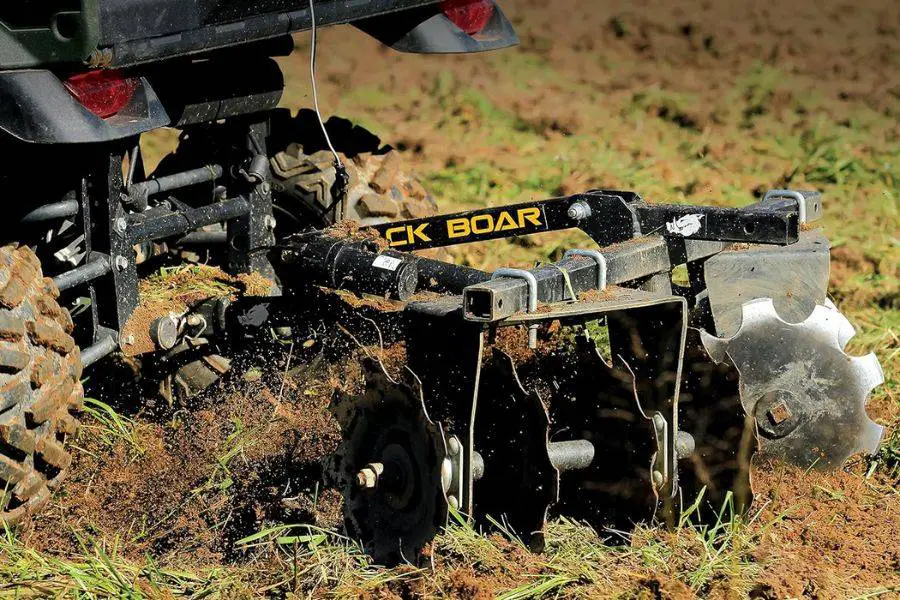Table of Contents
Before you plant crops, you must till and loosen the soil. It makes the ground softer and more manageable so the young roots can penetrate easily.
Most of us look for ways to make this work easier. And that is where a homemade pull behind tiller can come in handy.
You can use a tiller to cut through the soil to aerate and mix organic materials. They are handy for those who want to start a garden bed or revive old ones.
In the guide, we will teach you how to build one.

Considerations
Before we start building that tiller, there are several things you need to understand. Tillers indeed make the soil more porous, allowing roots to grow. But you must first know how to use one.
Do not use a tiller when the soil is wet. It will clod up and dry in thick crusts. A damp ball of soil is quite hard to till.
Tillers work wonders in mixing compost. After tilling, ensure you have applied enough organic matter to the freshly tilled soil. It will keep in the moisture and reduce weed.
Building The Right Tiller
Consider also that there are several types of cultivators. Establish which one is perfect for your job based on the workload.
Before making one, look at the size of the area you want to till. Also, consider how often you are likely to use the machine.
Here are the common types:
Mini Cultivators
Mini Cultivators are the smallest and lightest. They are best used in removing weeds and turning the soil in average-sized gardens.
Because they are very maneuverable, the tillers are ideal for small spaces. But they may not be suitable for heavy workloads.
Rear-Tine Tillers
Consider going for the rear-tine tiller if you have a more extensive garden. These are the largest cultivators, with the ability to dig a width of up to 700mm.
Usually, these tillers are self-propelled. They may come with synchronous tines that spin in one direction as the wheel.
Some may have counter-rotating tines, moving in the opposite direction.
Rear-tine tillers are heavier and hence, not very maneuverable. They may not be ideal for a small garden.
Front-Tine Tillers
These are rear-tine machines that you can push instead of pulling. They come with the same power and tilling capacity as the rear models.
They are also great for a larger planting area.
Pull Behind Tillers
Building a pull behind the tiller should be much better if you don’t want to wrestle with a front-tine tiller.
It is a cultivator to connect to your garden tractor and finish your work much faster.
Hand Cultivators
Building a pull behind tiller is an excellent idea. But first, understand that other options exist.
You can use a hand tiller instead. Instead of attaching the tiller to a puller, you can use a hand tiller.
It’s an excellent tool for blending the supplements into the soil.
Note that even a shovel can do the job. But it does not do well breaking the soil evenly.
Also, it can take a long time to finish any work.
A hand tiller should be a great option. But it does not do an excellent job if the garden is much larger.
Your Space
Any tiller should be a perfect choice. It only depends on the space you are working on.
So before we start the homemade pull behind tiller, recheck your garden. Is it:
- Narrow/compact? You may want the mini cultivator for such a space. They are easy to control and don’t take much space.
- Large space? Working in a larger space is more demanding. You may want to build an enormous pull behind the tiller.

A Homemade Pull Behind Tiller – Step-By-Step Guide
It is easier to ride a garden tractor that struggles with a front-tine rototiller. Here is a guide on how to make one.
Tools
- Two wheels
- A lever (you can use a trailer-mounted lever)
- Tines
- 2 by 2 steel tubing
- Safety gear
- Appropriate spanners and wrenches
- Homemade brackets
- A 1.4 –inch
- A jigsaw
- An electric drill
Assemble The Materials
You need to assemble all the materials. Since a pull behind tiller is an electrical machine most times, be ready to find the proper connection to the garden tractor.
Some of the materials you may need are listed above. Bringing along the safety gear is essential.
Some of the tools you will be using are sharp.
Build The Tongue
You can make the tongue based on the size of your tractor or ATV. In this case, we are using a 6-foot-long, red oak 4 by 4.
The width of the ATV is 42-inches. So, we can make our cultivator 46-inches wide so it can wipe out the tire tracks well.
While on it, make room for the digger within the length. It gives you a 42-inch long tiller.
You can use this example to decide your needs and design.
Drilling And Connecting The Parts
Screw two 2x4s on the port and starboard sides. At this point, your piece should look like a horse-drawn dag, only without teeth.
Drill the correct holes for fitting the draw pin on the drawbar of your ATV/tractor. Get a few pieces of flat iron bars.
Make them about 12-inches long, ¼ inch, and 1 ½ inch wide.
Attach the two iron pieces to the tongue, at the top and the bottom.
Connecting The Pines
You can use a few scraps of 2×12 pine. Ensure they have the correct width to make circular cutouts for the wheels (11-inch in diameter).
Cut these pieces using the jigsaw and ensure the center is well marked. An old piece of good pipe can serve as an axle.
Use a hole saw and an electric hand drill to create holes in the wheel for the axle.
Put cotter pins through the axle on either side. Also, place washers on either side of the wheel.
It keeps the wheels running without coming off.
The Pines
You can scavenge digging pines from an old cultivator. Put them on the machine and secure them well.
An electromechanical device can be used to lift the tines. But you can apply any other tool to lift them.
For instance, use a 4×4 red oak based on the width of the cultivator. As you pull wood close to the axle of the tines, it raises the tines well for transportation.
Ready For Trial
Your homemade pull behind tiller is now ready for trial. It can take about three or four trips over the stern, overgrown ground to get the ground ready.
Early spring is the best season to test your machine. At this time, first growth is just starting.
Conclusion
Building a homemade tiller may seem time-consuming and tiring. But it’s pretty fun.
You can design your machine and customize it to meet your needs.
The materials used above are what we could find for this demonstration. You can substitute them with anything workable lying in your yard.
Now you don’t have to spend much money to mechanize your garden work. Go on and try making your pull behind tiller.








